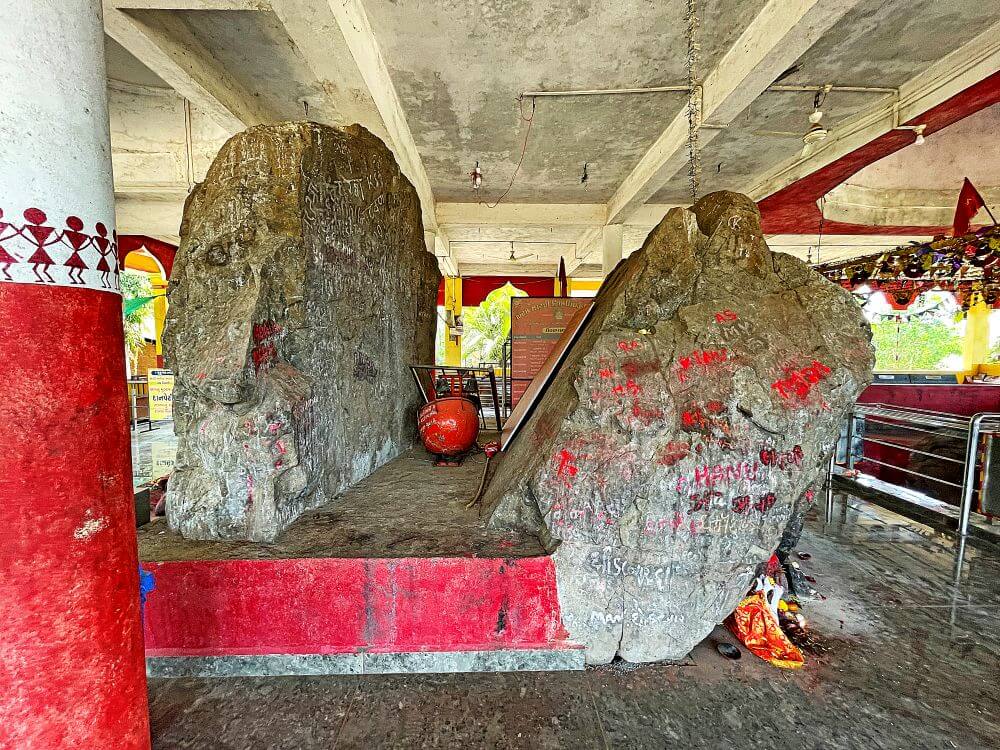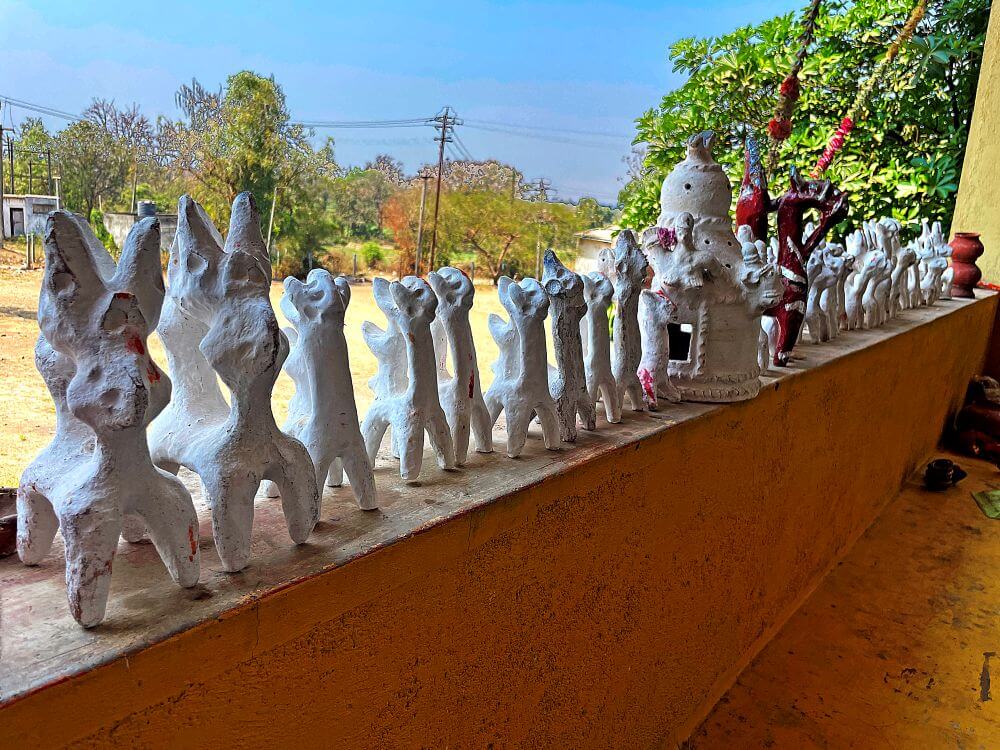 Devalimadi Mata is the kuldevi (family deity) of tribal communities in Gujarat and Madhya Pradesh, especially revered by the Gamit community. She is also worshipped as Kani-Kansari, the goddess of grains. The Devalimadi Temple, located in Devalpada, is a major center of devotion for countless local tribal devotees. There is a tradition of offering the first harvest from the field to the goddess. It is also believed that Devalimadi is a goddess who grants children and many people pray to her with vows for offspring. Every year, a large fair is held here on Margashirsha Purnima (full moon day).
Devalimadi Mata is the kuldevi (family deity) of tribal communities in Gujarat and Madhya Pradesh, especially revered by the Gamit community. She is also worshipped as Kani-Kansari, the goddess of grains. The Devalimadi Temple, located in Devalpada, is a major center of devotion for countless local tribal devotees. There is a tradition of offering the first harvest from the field to the goddess. It is also believed that Devalimadi is a goddess who grants children and many people pray to her with vows for offspring. Every year, a large fair is held here on Margashirsha Purnima (full moon day).
Devalpada is located in Songadh Taluka, a historically significant region. Songadh Fort was the first outpost in this region established by Pilajirao Gaekwad, founder of the Baroda State. In 1719, he defeated the local Bhil tribes and captured the fort, later reinforcing it in 1721 with their help and even building a grand residence inside. About 16 km from Songadh, atop a hill in Devalpada, lies the original sacred site of Devalimadi Mata. Scholars believe that Devmogra and Devalimadi, both tribal goddesses, share similar attributes and are worshipped among the Bhil tribes. Stories and folk songs from the region often recount legends about this goddess.
One such legend says that Devalimadi was the sister-in-law of Sonarya Dev, the husband of her sister.  He wished to marry her and make her his queen, but she rejected his proposal. To escape him, she hid in the forested hills near Devalpada and Duswada. However, Sonarya Dev saw her there as well. To avoid him, she moved westward and hid near a large rock, where she finally settled. This rock is believed to be the hilltop at Devalpada, where the goddess originally resided. Over time, she moved down to the village of Devalpada and a large temple was built in her honor.
He wished to marry her and make her his queen, but she rejected his proposal. To escape him, she hid in the forested hills near Devalpada and Duswada. However, Sonarya Dev saw her there as well. To avoid him, she moved westward and hid near a large rock, where she finally settled. This rock is believed to be the hilltop at Devalpada, where the goddess originally resided. Over time, she moved down to the village of Devalpada and a large temple was built in her honor.
The temple is located at the entrance of Devalpada village, within a large open courtyard. A cemented gateway marks the entry, beyond which lies the temple structure. The temple consists of a mukhmandap (entrance porch), a sabhamandap (assembly hall) and an open sanctum (garbhagriha). From the domed porch, six steps lead up to the spacious, semi-open sabhamandap, which has cement benches along all four sides. The square inner pillars are painted with Warli-style tribal art and steel railings form a queuing line for darshan.
The square inner pillars are painted with Warli-style tribal art and steel railings form a queuing line for darshan.
Upon entering the Sabhamandap, two stone boulders about one and a half men’s height immediately attract attention. These stone boulders are original, and a small platform has been built around them. There are four idols of tribal deities on it. These idols of the deities on horseback are made of clay. Similar idols are offered to the goddess here as fulfillment of vows. Many such idols can be seen on the walls of the Sabhamandap. In one corner, there are also photographs of young children, placed by devotees as a gesture of gratitude.
The Garbhagriha of the goddess is located in front of these stone boulders.  Its uniqueness is that it is in the lower part from the ground level. A high cement railing is built on three sides of it, and the front side is closed with steel bars. There are steps to go down from here. Below, there is a stone image of Devalimadi Devi between three large stone blocks. This image is covered with colorful Chunaris (shawls). A picture of the goddess is placed above this stone block. A tall spire of the temple is built directly above this Garbhagriha.
Its uniqueness is that it is in the lower part from the ground level. A high cement railing is built on three sides of it, and the front side is closed with steel bars. There are steps to go down from here. Below, there is a stone image of Devalimadi Devi between three large stone blocks. This image is covered with colorful Chunaris (shawls). A picture of the goddess is placed above this stone block. A tall spire of the temple is built directly above this Garbhagriha.
After visiting the goddess in this temple, many devotees also trek to the original hilltop shrine. A small concrete path has been built from the road in the village to the foot of this hill. Further ahead is the entrance arch. Near it, on the right side, there is a large platform built like stairs. Pictures of tribal gods and goddesses and saints are displayed on it. In the middle is a stone Taandala (a symbolic stone representing the deity) of the goddess. In front of it are some small and big brass Trishuls (tridents). Many pictures of small children are displayed in the upper part.
In the middle is a stone Taandala (a symbolic stone representing the deity) of the goddess. In front of it are some small and big brass Trishuls (tridents). Many pictures of small children are displayed in the upper part.
From this point, steps lead partway up the hill, after which the trail continues on a natural dirt path through the forest. Along the way, there is a small platform under a tree known as the Devi’s Chowki (seat). A little further ahead, in a small cave-like stone area, lies the original sacred site of Devalimadi Mata.
Like the temple in Devalpada village, here too, devotees offer the first crop from their fields to the goddess. Clay horses and similar idols are offered. A large fair of the goddess is held in this temple every year on Margashirsha Purnima. Along with the tribal people from Surat, Tapi, Dang, and Narmada districts of Gujarat, devotees from states like Madhya Pradesh also come in large numbers to visit the goddess at this time. Various religious and cultural programs are also organized during this fair.
